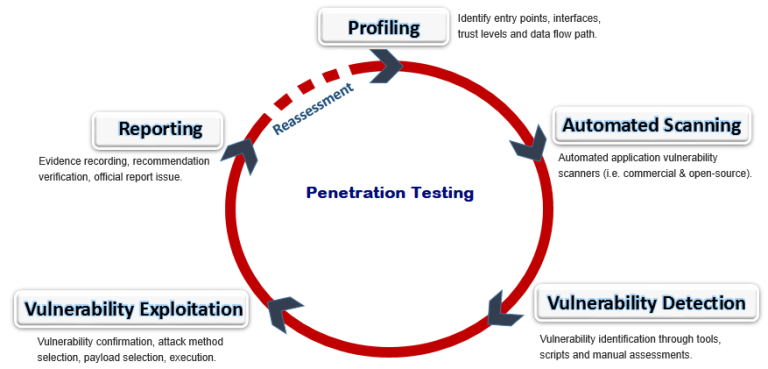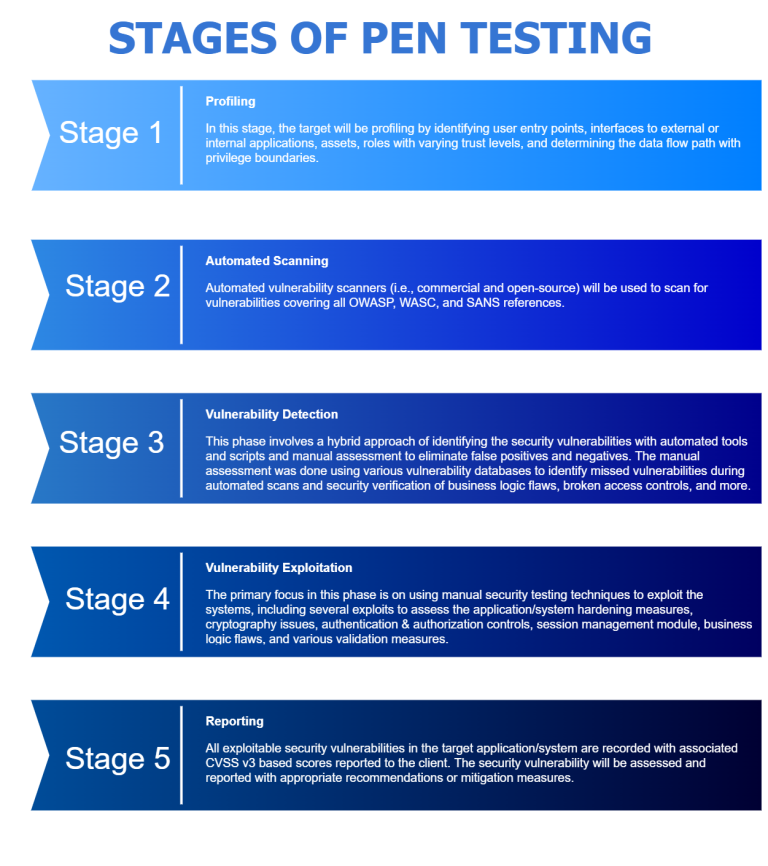Pen Testing Guide

It’s no longer enough to have a firewall and anti-virus software and to believe your company is secure. A sophisticated approach to security and due diligence is necessary for modern businesses.
High-profile security breaches continue to dominate the media. Malicious hackers are actively developing new and more sophisticated forms of attacks on a daily basis. This trend puts an increasing number of businesses at risk.
Planning and evaluating existing infrastructure can only go so far in creating cybersecurity strategies. You must think about your business from a hacker’s point of view to develop an impenetrable security strategy. Pen Testing serves this purpose.
When properly executed, Pen Testing can offer insightful information about the advantages and disadvantages of your company’s online security measures.
Learn more about Pen Testing and why every business should conduct one.
Article's content
What is Pen Testing?
Pen Testing is an authorized, simulated, ethical cyberattack on IT infrastructure to evaluate its security. When the security level is evaluated, the system’s robustness to withstand any attack, either internally or externally, must be analyzed. Pen Testers mimic the actions of hackers and try to find the vulnerabilities in the system that can be exploited.
A vulnerability is a known weakness or error in the system that can be exploited to affect the system adversely. A threat is anything that can exploit the vulnerability. A risk is a potential loss, damage, or destruction of assets caused by the threat. Any available vulnerability leads to a threat that increases the chances of risk.
The hacker taking money from bank accounts is a risk. For Example, a banking system allowing unauthorized access is a vulnerability. A hacker trying to access the banking system is a threat due to this vulnerability to access accounts.
Pen Testing helps an organization list the risks in their system so that they can be prioritized and fixed to have a secure system.
8 Benefits of Pen Testing
Some of the key benefits of Pen Testing include:
- Evaluate Infrastructure/System Security – Secure Infrastructure is extremely important for any organization. Pen Testing helps to evaluate the security of the infrastructure and system.
- Identify and Prioritize Risks – Pen Testing provides the list of vulnerabilities in the scope of Testing along with the risks associated with it. The risks are ranked by their severity which can be prioritized and tackled sequentially.
- Allocate Security Budget – When the system is evaluated and the weaknesses are identified, the organization gets a clear picture of what remediation is needed. Budget allocation can be done conclusively to modify and strengthen the security posture.
- Regulations and Compliance – Every organization must follow certain regulations based on the industry or the data they handle. Pen Testing helps organizations to be compliant with standards such as ISO 27001, GDPR, HIPAA, SOC 2 and PCI DSS
- Customer Trust and Company Reputation – Any Business has a customer. And Business continuity involves customer satisfaction. The confidence that their data is secure has to be evident to gain customers’ trust. A company compliant with standards and regulations demonstrates its reputation.
- Security Awareness – Though Pen Testers help evaluate the system’s vulnerabilities, employee security awareness is very important. If even a single employee is unaware of the prevailing cyberattacks, he/she may be the cause of vulnerability which is a big threat to the organization.
- Prevention of Financial Loss – Loss in case of a breach-Even a simple cyber attack on the system can cause huge financial loss to an organization. Such a significant loss can be avoided by assessing and managing the vulnerabilities.
- Enhance the Incident Response Procedure – Gain a better understanding of handling incident response after a penetration test and how it is recorded, cataloged, and forensics conducted on the security event.
Difference between Hacker and Pen Tester
Though a Pen Tester pretends to be a hacker they have distinct differences.
Pen Tester | Hacker |
|---|---|
Authorized to simulate an attack to evaluate the security of the system/organization | Illegally attacks a system |
Aims to identify the weakness of the system and list the risks and threats associated | Aims to damage the system or steal data for some personal benefit |
When Pen Testers exploit the vulnerability, they don’t misuse the system | When hackers succeed in accessing the system, they might engage in malicious activity |
Difference between Pen Testing and Vulnerability Assessment
Penetration testing exploits a flaw in your system architecture, whereas vulnerability Assessment checks for known flaws and generates a risk exposure report. They have different objectives.
Vulnerability Assessment | Pen Testing |
|---|---|
Identify weaknesses in the system | Simulates real-world attack and tests the defensive controls in place |
Discover the vulnerabilities | Exploit the vulnerabilities to identify the threats |
Provide quick insight into cyber security | Deeply examine the cyber security |
Performed by an automated process using advanced tools | Performed by qualified Pen Testers with a methodological approach |
Create a report that lists the discovered vulnerabilities, ranked by severity and/or business criticality | Create a Pen Test report that lists the vulnerabilities, ranked by severity and the steps taken to exploit them. It also shows the risks associated and the recommended remediations. |
Types of Pen Testing
Below are the various types of Pen Testing based on the scope and testing objectives:
External/Internal Network Pen Testing – The main objective is to evaluate the network – internal/external. The network infrastructure, including servers, firewalls, switches, routers, and printers, are tested for vulnerabilities. While the External Pen Tester pretends to be a hacker trying to break the firewall/load balancer and access the system from outside the network, an internal pen tester acts as a malicious insider who tries to hack the system with a certain level of access to the internal network.
Web Application Pen Testing – This covers web applications’ code, design, and development review of web applications to remediate any vulnerability. The security features of the application facing the internet are screened thoroughly. As the hacking techniques evolve daily, it is advised to frequently test the web applications for vulnerabilities frequently.
Mobile Application Pen Testing – With the increasing number of applications being compatible with different client interfaces, applications are now mandated to be accessible through a mobile environment. The mobile environment is more prone to security breaches if not thoroughly tested thoroughly. Mobile application Pen Testing helps to evaluate the application’s security in a mobile environment.
Wireless Network Pen Testing – Wireless Network Pen Testing Targets Wireless networks and wireless protocols, including Bluetooth, ZigBee, and Z-Wave. As a Wireless network is a vulnerable access point of an organization, it has to be more secure with no vulnerabilities.
Social Engineering Assessment – While other types of Pen Testing evaluate the system’s security, Social Engineering Assessment evaluates the Employee’s security exposure. The effectiveness of human-related security initiatives is quickly determined, as well as the problems that need to be fixed.
Based on the approach and the knowledge of the targets in scope, there are types of Testing – Black Box, White Box and Grey Box
Black Box | White Box | Grey Box |
|---|---|---|
The Tester does not have any information on the system in scope | The Tester has complete knowledge of the system in scope | The Tester has limited information on the system in scope |
Simulates an external hacker | Simulates a targeted attack on a specific system utilizing as many attack vectors as possible. | Simulates an insider threat or an attack that has breached the system access |
Also known as Opaque-box testing | Also known as clear-box testing | Also known as Translucent-box testing |
Example – A Web Application tested with no user access | Example – A Web Application testing with low-level user access | Example – A Web Application tested with multiple users with |
5 Stages of Pen Testing

The Open Web Application Security Project (OWASP), NIST, and PTES provide Pen Testing standards. databrackets’ security assessment methodology aligns with the OWASP standards and the industry’s leading security consortiums such as SANS, CWE, WASC, etc.
Pen Testing is carried out in five stages – Profiling, Automated Scanning, Vulnerability Detection, Vulnerability Exploitation and Reporting
Highlights of activities performed in each of the stages are described below:

How to define the scope of Pen Testing?
Any testing procedure needs a defined scope to plan the methodology, tools, cost, and efforts. The scope of Pen Testing defines the boundaries, targets, and depth of the system to be tested. The following factors should be considered while defining the Scope of Pen Test:
- The scope has to be clearly agreed upon and communicated between the customer and the Pen Tester
- The assets that are in scope and out of scope have to be explicitly agreed upon and documented
- If the scope is too narrow and does not cover the complete boundary, vulnerabilities and the related threats might not be discovered
- If the scope is too broad, exceeding the boundary of the system, then it might end up in loss of time, cost, resources and unnecessary probing
What is included in a Pen Testing Report?
The Pen Testing report includes the following items:
- Executive Summary – This section of the Pen Testing gives the high level overview of the Pen Test – the scope of the pen test, the period of the test event and the summary of the vulnerabilities and threats identified
- Methodology -The detailed methodology used to perform the Pen Testing. This covers the types of testing performed, the steps taken during each phase, and how the attacks were executed. This also describes the Risk Rating Scoring system based on which the severity is defined
- Tool Used – This section of the report details the various tools used to perform the Pen Test
- List of vulnerabilities – This section captures the vulnerabilities detected during the Pen Test
- Risks – This section lists the impact of the vulnerabilities detected during the Pen Test
- Evidences – Whenever a vulnerability is listed as identified, the supporting evidence that shows the vulnerability exploitation or the clear evidence of vulnerability existence is provided. This gives the customer a better understanding of the threat
- Remediation Recommendations –Recommendations to address the vulnerabilities and remediate the threats
How often should you get a Pen test?
Pen Tests should be performed at least once a year. However, it is recommended to do a Pen Test whenever there is a major change to the infrastructure or application. PCI DSS suggests a Pen Test every six months or after a major change to the system.
What happens after Pen Testing?
After Pen Testing, the vulnerabilities have to be remediated. The risk prioritization is analyzed, the budget is allocated for risk mitigation, and the changes are done.
Reviewing Pen Test results is a great opportunity to discuss future plans and review the overall security posture.
Pen Test results can be taken into takeaways that will help reshape larger security policies and action items for immediate remediation with review and evaluation.
How much does it cost for a Pen Test?
Pen Test cost vary based on multiple factors like Complexity, Scope, and Methodology
Organization Size | *Cost Estimate (USD) |
|---|---|
Small to Medium | $ 8,000 – $ 10,000 * |
Large | > $ 10,000 * |
* Disclaimer: This cost estimate is an approximation and is not guaranteed. The actual cost may change once all project elements are finalized or negotiated.
Pen Testing for Compliance
Pen Testing validates a company’s security and remains evidence of compliance with many standards. Below is the list of a few common Standards and the Pen Test requirements.
Regulations/Standards | Is Pen Testing Required? | Recommended type of Testing |
|---|---|---|
ISO 27001 | Yes | Third-Party |
SOC 2 | Yes | Third-Party |
GDPR | Yes | Third-Party |
PCI DSS | Mandatory | Certified Qualified Security Assessor |
HIPAA | Recommended | Third-Party |
Why do you need Third-Party Pen Testers?
- Certified Pen testers are mandated by certain compliance and standards
- Organization can test their readiness in case of a real cyber attack
- Employees’ security awareness can be put to a test
- Clients can be assured of security level when a third party provides a report
- Pen Testing tools and techniques might require a big investment if done internally. Third-party Pen Testers are cost-effective
- The latest Tools, Tactics, and Procedures (TTPs) can be adopted
- Likely to find more vulnerabilities than the internal team as Pen Testers will try to look at the system from the hacker’s point of view
Why choose databrackets for Pen Testing?
- databrackets’ security assessment methodology has been aligned with the OWASP standards and the industry’s leading security consortiums such as SANS, CWE, WASC, etc.
databrackets is accredited by reputed organization - Expert Pen-Testers
- Combination of manual and automated processes
- Quick Turnaround Time
- High ROI
- Report walkthrough
- Remediation validation
We welcome your inputs, questions, and comments about this guide. Please send us your feedback by writing to info@databrackets.com or schedule a consultation.
Explore our Pen Testing FAQs
Major cloud security vulnerabilities are account hijacking, data privacy breach, malicious insiders, insecure APIs, data leaks and data loss.
Without validation there is no assurance that the vulnerabilities have been remediated. When the vulnerabilities have been discovered through a pen test, the remediations should also be validate by retesting.
Article 32 of GDPR insists on a process for regularly testing, assessing and evaluating the effectiveness of technical and organizational measures for ensuring the security of the processing. One such important process is Pen testing.
Yes. Pen testing is an essential component of complying with ISO 27001 standards. The objective of ISO 27001 Annex A.12.6.1 is about the technical management of vulnerabilities.
Penetration testing is a mandate to maintain PCI DSS compliance. PCI DSS requirement 11.3 states the importance of Pen testing. It insists on external pen testing every six months or after a significant change to the infrastructure or application.
Based on the scope of the pen tests, few common vulnerabilities pen tests look for are listed below:
External/Internal Network | Unauthorized Access |
Distributed Denial of Service | |
Man in the Middle | |
Malware | |
SQL Injection Attack | |
Web Applications | Cross-Site scripting |
Injection Attacks | |
Zero-Day Attack | |
Brute Force Attack | |
Wireless Network | Packet Sniffing |
Wardriving | |
Jamming | |
Evil Twinning | |
Social Engineering Attacks | Phishing |
Baiting | |
Scareware | |
Tailgating |